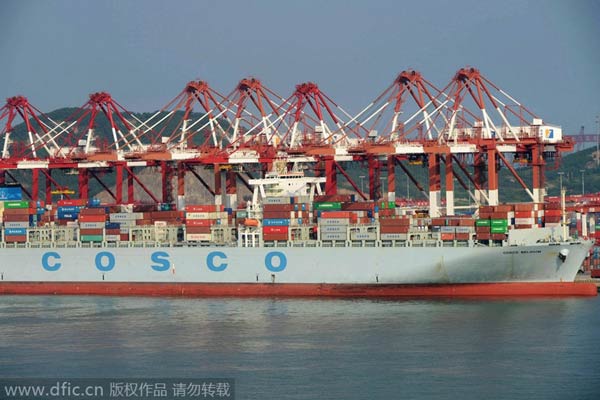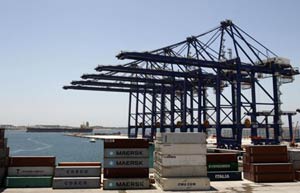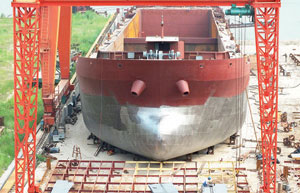 |
|
A fully-loaded container ship of COSCO departs from the Port of Qingdao in Qingdao city, East China's Shandong province, August 8, 2014. [Photo/IC] |
China COSCO Holdings Co, the container shipping line that posted three annual operating losses, said adding more fuel-efficient vessels will help cut costs enough to revive profits amid a capacity glut.
"The ships need to be filled for the cost savings to be achieved," said Guo Huawei, board secretary, in an interview on Friday. Operating bigger carriers can be "a double-edged sword", he said, as he declined to give an estimate for earnings or say when the company is likely to return to profit.
COSCO ordered five fuel-efficient container transports that carry as many as 14,500 20-foot boxes for delivery between 2017 and 2018, the Beijing-based company said last week.
The ships are slightly smaller than the industry's largest on order by rivals including China Shipping Container Lines Co and AP Moeller-Maersk A/S, which are betting on economies of scale from vessels large enough to carry as many as 19,100 containers.
 |
 |
COSCO's container arm cut fuel spending by 18 percent in the first half of the year by sailing ships more slowly, which boosts efficiency, according to the company's first-half earnings statement. Containers used to deliver consumer goods such as clothing, bicycles and televisions accounted for about 73 percent of revenue last year, according to data compiled by Bloomberg.
Dry bulk shipping, including grain and ore, accounted for about 21 percent.
Container lines face increasing cost pressure as rates have yet to fully recover from a plunge during the 2008 financial crisis. Prior to the global credit meltdown, Chinese and South Korean yards expanded production of container ships to meet demand that never materialized, leaving the industry weighed down with overcapacity.
"Most of us thought the market would have improved considerably by now, but we still have the same overcapacity concerns today," said Guo. "It's unclear when this will end. Under these circumstances, reducing costs is the most realistic strategy."
While COSCO adds larger fuel-efficient ships, competitors such as Maersk and China Shipping Container Lines deploy the largest carriers to gain leverage within global shipping alliances that are increasingly important for filling vessels.
"Many of its container and bulk ships are obsolete and lack competitiveness," Winnie Guo, a China Construction Bank Corp analyst, wrote in a note about COSCO dated Aug 28.
COSCO will probably report a net loss of about 1.06 billion yuan ($173 million) this year, according to the average of eight analyst estimates compiled by Bloomberg. The annual loss would be the fourth since 2009.
Sales have dropped by half since reaching 132 billion yuan in 2008, to 66 billion yuan last year.
The company does not announce or disclose earnings forecasts.
The shipping company last year reported its first net income in three years, narrowly averting delisting of its Shanghai-listed A shares. China COSCO disposed of assets including a logistics unit last year.
